Bulletin d’Information de Groupe Broderie de CIETA
No 3
September
1996

ANNE WANNER'S Textiles in History / CIETA Embroidery Newsletters
| Newsletter
- of the CIETA Embroidery Group Bulletin d’Information de Groupe Broderie de CIETA No 3 |
 |
| Dear members, | St. Gallen, 19th september 1996 |
| thank you very much for
your cards and letters giving various pieces of
information. The more you contribute the more it will
become your letter of information ! As you will very well
see in this letter, I was much impressed by my recent
visit to St Petersburg. In the Hermitage Museum there was
an exhibition on historicism in Russia, which gave also
an idea of the 19th century textile collection. The
textile department forms part of the Hermitage Museum. If you have some interesting new acquisitions, please send me a photograph, I should be delighted to publish it. Would you be interested in starting a discussion about embroidery techniques ? Awaiting your news, I am sending to all of you my best wishes, yours Anne
Wanner-JeanRichard |
General
Information: |
| General Information:
ICOME-Costume Group (embroidery section): a letter about exchanging news has not been answered French embroidery group: The State
Hermitage Museum in St Petersburg, Russia,
organizes a conference from October 21st to 24th 1996: "Historicism
in Russia. Style and Epoch in the Decorative Arts. 1820s
- 1890s". Marie-Dominique Frieh, Lyon, secretaire generale, informs about the CIETA-meeting in September 1997 in Cambridge: small rooms for the specialist groups are already pre-booked. We can meet before the conference and a possible program should be made as soon as possible. Would you like to bring along photographs of special embroideries, maybe of interesting church embroideries? Should we rather discuss embroidery techniques? Please send suggestions to my adress. Marie Schoefer, of the Musee Historique des Tissus sent information about the exhibition in Lyon (see letter). She also mentions an inventary on the embroidery collection (mainly European) from the 16th - 19th c. that is being made at the museum. It contains fragments of furniture and also costumes. So far nothing has been published. Birgitt Borkopp
sends exact title and date of the exhibition in Munich: |
Centre
de Documentation France Nathalie Jarniat,
Secretariat General, informe: 1 - la creation d’un
Centre de documentation et de recherches, |
| Colloque International
du novembre 1997 à Paris: La Broderie de
l’Antiquite à Nos Jours: 1. R. Benthouami, Paris: La
broderie marocaine, techniques et outils. La Broderie Contemporaine 20. M.
Fouriscot, Paris, dirigera les tables rondes sur: La
broderie contemporaine. Elle accueillera des artisans,
des industriels, des createurs ..... Participeront aux debats: L. Kamitsis,
(Directrice des Projets au Musee de la Mode et du Textile
à Paris) pour une intervention sur la dialectique entre
une technique de broderie et un style de vêtement
(exemples chez Vionnet, Schiaparelli, Paco Rabane) Renseignements: |
New
acquisition, Freiburg Breisgau Saskia Durian-Ress publishes a new acquisition in:
Jahresbericht 1994 (annual report) |
| The
embroidery used to be the front cover of a Bursa in a
very fine embroidery technique, probably made near
Cologne. The silk embroidery shows split stitch. The
silver and partly gold thread is worked in couched
stitching. The embroidery used to be the front cover of a Bursa in a very fine embroidery technique, probably made near Cologne. The silk embroidery shows split stitch. The silver and partly gold thread is worked in couched stitching. |
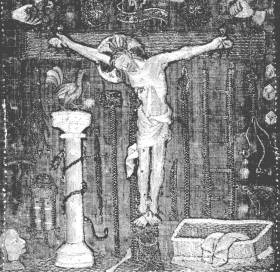 |
New
acquisition, Luzern Ursula
Karbacher informs about a new acquisition, |
| Coat of arms: the families Knab and Schindler are extinct, regimental families of the town of Lucerne. An alliance of the two families has not been proved so far. |
|
|
Question,
Luzern Ursula
Karbacher notes a special ground fabric on |
| This altar frontal was
embroidered by the sisters Margareta and Anna Von Ulm.
They both were Dominican nuns in the convent of St
Katharinental. (Margareta died in 1593 and Anna in 1600).
The ground fabric is composed of different, sometimes small pieces. Why did the sisters use this patched ground? An embroidery of this quality could be very well worked on a new ground. Could the patched ground have been a special fabric, maybe a former dress or cloth to remember someone, e.g. the parents of the two nuns? Question: Does anyone know of similar embroideries, worked on special and already used ground fabric? |
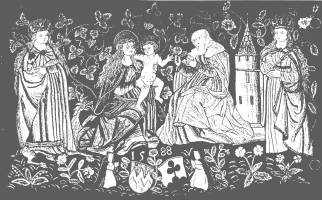 |
Question,
Munich, pulled threadwork |
| Bayerisches
Nationalmuseum, Munich, by Birgitt Borkopp, Sampler, Germany, middle of 18th century Birgitt Borkopp sent the photo of this very fine sampler with "Dresdenwork" (pulled threadwork) from the Munich collection. Does someone have similar samplers and more information about where and when these works have been done? detail of Sampler |
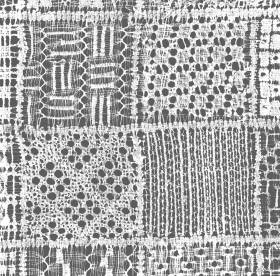 |
| Sampler, pulled threadwork, Bayerisches Nationalmuseum, Munich, Inv.Nr. T 3760 | 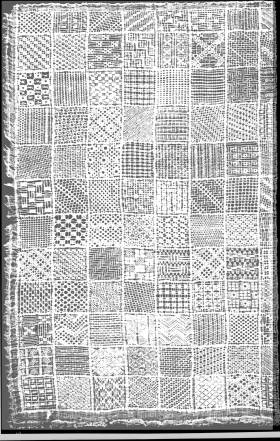 |
Textilmuseum
St.Gallen, pulled threadwork |
| Textilmuseum
St.Gallen, by Anne Wanner, embroideries, Germany, middle of 18th cent. In: Textile Museum Journal 1977, vol.4, p.35 the terminology of openwork embroidery was discussed and 6 american specialists (Coleman, von Rosenstiel, Bidner, Sonday, Moss, Merritt) proposed to use instead of "pulled work" deflected element embroidery. The definition is: no elements have been removed from the foundation fabric. The embroidery thread forces elements of fabric out of alignement. |
pulled threadwork, detail of "engageante", Germany, 1763, St Gallen TM 21192 (left) |
| The technique of the following examples is pulled threadwork or deflected element embroidery. The threads are pulled in one or both directions. An additional thread creates different surface pattern. In german of the 18th cent. the names "point de Dresde" and "point de Saxe" are used as well as "Ajourarbeit". In Switzerland the technique is called "Zughoehl". | 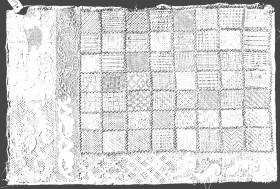 pulled threadwork, Sampler, 36,5 x 24cm, Germany, middle 18th c., St.Gallen TM 20209, Sampler cat.Nr. 207 (right) |
article:
pulled threadwork, Chicago |
| Article
by Christa C. Thurman, Chicago in: The Art Institute of Chicago Museum Studies, vol.21, no 1, p.49, publication of the presentation on CIETA-Congress in Paris, September 1995 A First or
Second Empire Terpsichore: that is the question |
Panel of
Terpsychore French, 1804/15 or 1852/70 |
| A
table-cloth of V&A Mus. London shows similar
pulled threadwork. Its provenance is not known in London.
Clare W. Browne from London kindly sent the close-up here
published. Close-up of table cloth, V&A Museum London, Nr.Circ. 128-1951 |
|
| Contribution to Christa Thurman’s article, found in a catalogue of the Paris world exhibition of 1878. The following picture of a furniture decoration of Christofle & Co in Paris and shows that Percier’s and Fontaine’s compositions were still fashionable in 1878. Catalogue of Paris World exhibition
1878, Leipzig 1880, engraving for furniture decoration, |
|
Article: hangings |
| Article
by Margaret Swain, Edinburgh in: Proceedings of the Society of Antiquaries of Scotland, 124 (1994), 455-466, The Lochleven and Linlithgow hangings |
Exposition
Musee Tissus Lyon |
| Communique
(contact presse: Françoise Desprez, tel 72.40.58.37), Exposition du musee des Tissus de Lyon, "les ornements liturgiques au XIX siecle" 26 octobre 1996 au 28 fevrier 1997, 130 pieces au total seront
presentees, dans le cadre du centenaire de la
consecration de Notre Dame de Fourviere. Issues des
collections du Musee des Tissus, elles illustrent les
elements necessaires à la celebration de la messe tout
au long de l’annee. Parmi les entreprises les plus productives se detachent les noms des Maisons Tassinari-Chatel et Viennois, Archirel, Didier-Petit, Poncet, Lamy et Giraud. |
| Trois pieces
de reference de la Maison Henry sont presentees
dans l’exposition: - le dais de procession de Notre Dame de la Salette (1874-1876) qui represente 70 personnages en procession convergeant vers la Vierge et Pie IX, parmi lesquels on remarque les grands evêques de Lyon et de nombreux saints français. Une selection des esquisses et mises en cartes accompagne cette piece. - un livre de priere tisse (1887-1889) qui a ete confectionne en une trentaine d’exemplaires et a necessite deux ans de travail. Textes et enluminures sont en satin de soie. - un "ensemble Angelique" (1891), en soie, qui comprend la chasuble, le voile de calice, l’etoile, la bourse, le manipule. Les dessins preparatoires presentes sont dus au dessinateur lyonnais Gaspard Poncet. Les autres pieces de l’exposition proviennent soir des Prud’hommes, aupres desquels les soyeux lyonnais deposaient leurs echantillons textiles, soit de paroisses ou congregations lyonnaises, comme les Jesuites. Toutes ces pieces en reserve dans des albums ou des cartons du Musee des Tissus, et qui n’ont jamais jusqu’à present ete presentees au public, ont ete nettoyees ou restaurees dans l’Atelier de Restauration des Textiles anciens du Museee afin de paraître dans tout leur eclat. |
brode d’or en relief, Musee des tissus Lyon Tissage lampas et broderie d’orfroi aux fils d’or et de soie rouge.
Dalmatique, XIXe s., Lyon, drap d’argent Chape XIXe s., Lyon, provient de la maison "Henry". |
Exhibition St.Petersburg |
| Exhibition
in St Petersburg, reported by Anne Wanner, Historicism in Russia: Style and Epoch in the Decorative Arts 1820’s - 1890’s St Petersburg, Hermitage (May 1996 - fall 1996). cost of catalogue: R 160’000 Exhibition catalogue in russian and english,
ISBN 5-88654-019-9, printed by P&CS - Italy, |
book review: Baron
Stieglitz Museum |
| The Gems
of St Petersburg: Baron Stieglitz Museum, the past and
the present St
Petersburg 1994, ISBN 5-900813-01-0, |
book review: 125 jaar
Tesselschade-Arbeid Adelt Vilan van de Loo, book review: Inventaris S. Grieten & J.
Bungeneers (eds), |
| home newsletters | Last revised August 12, 2000 |